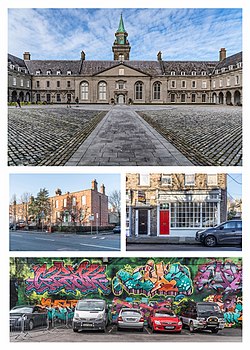Dublin 8 (D8) | |
|---|---|
Postal district | |
 Clockwise from top: Royal Hospital Kilmainham, a shopfront in Portobello, graffiti near Meath Street, the South Circular Road | |
| Country | Ireland |
| Province | Leinster |
| Local authority | Dublin City Council |
| Dáil constituencies | |
| EP constituency | Dublin |
| Postal district(s) | D8/D08 |
| Dialing code | 01, +353 1 |
Dublin 8, also rendered as D8 and D08, is a postal district in Dublin. Dublin 8 is one of only two postal districts to span the River Liffey, the other being Dublin 20 immediately to the west. While the majority of the district's built up areas are on the southside, it also includes northside areas such as the vast Phoenix Park. [1] A 2018 article in The Irish Times noted that, while the area was historically known for the manufacture of silk and wool, Dublin 8's "streets, alleys and quaysides are [now] replete with hipster cafes, cocktail bars and family-friendly restaurants". [2]





